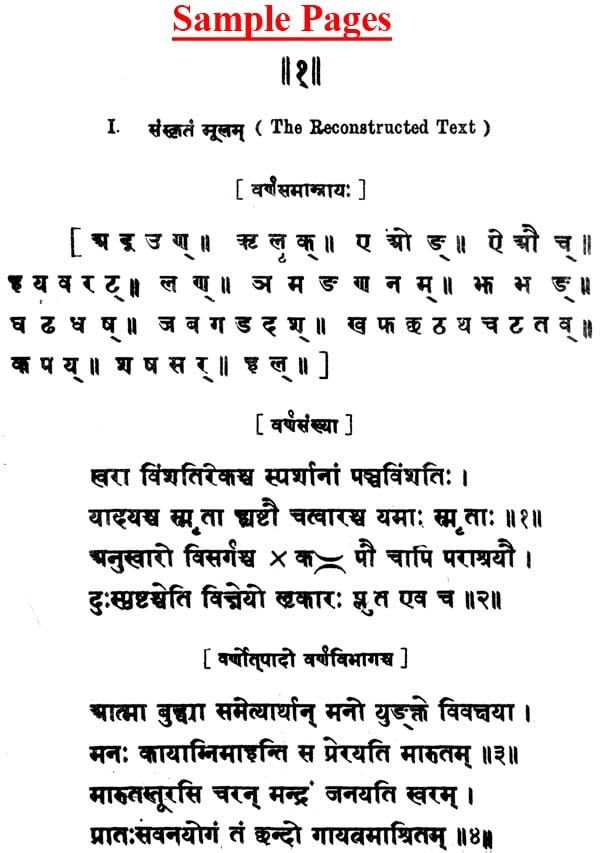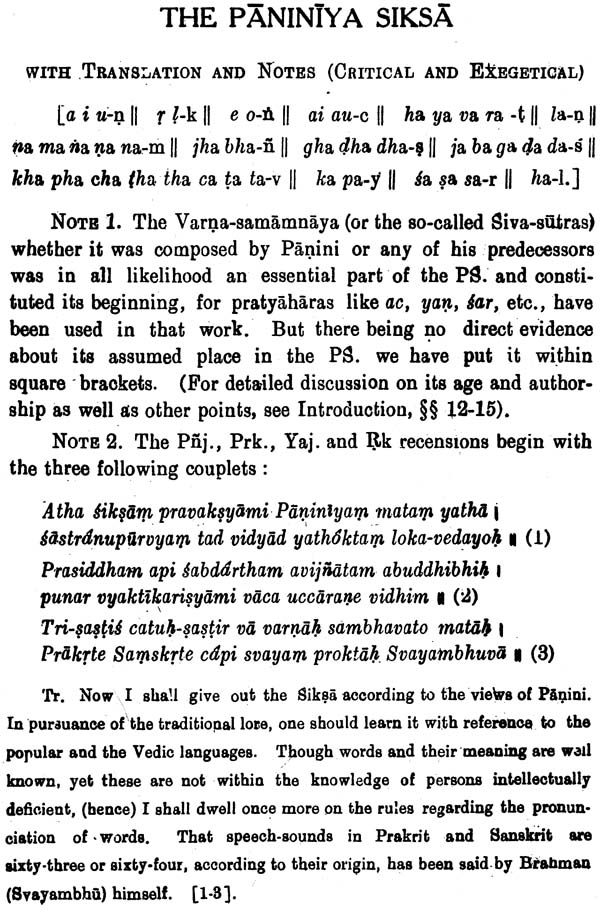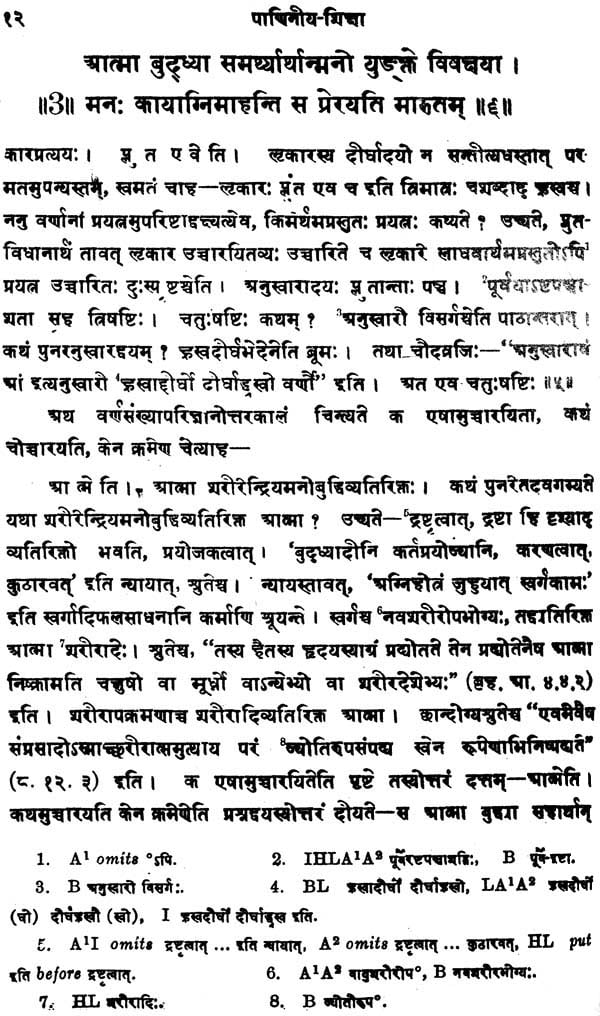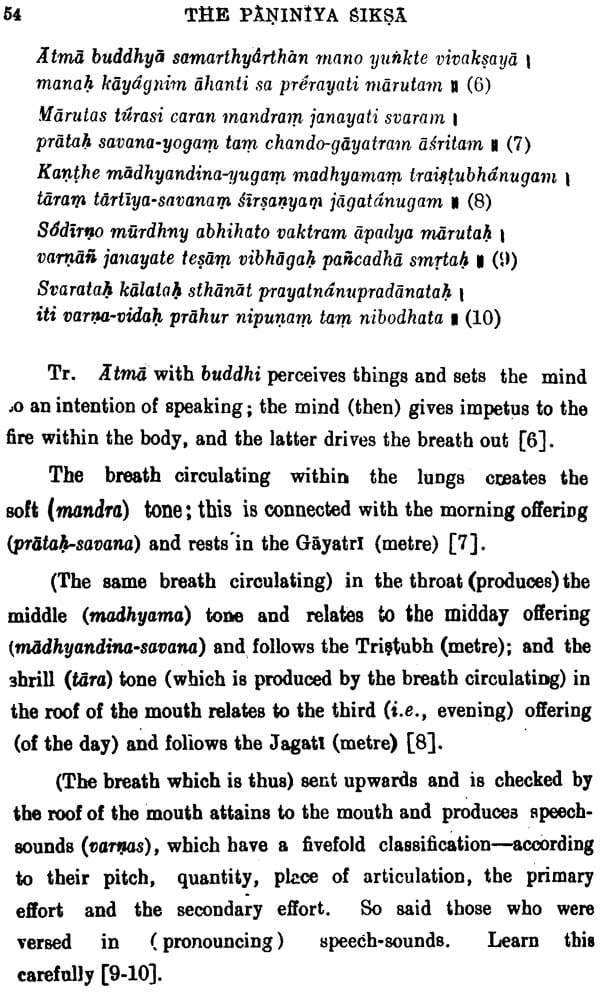
Paniniya Siksa (An Old and Rare Book)
Book Specification
| Item Code: | NAP395 |
| Author: | Manmohan Ghosh |
| Publisher: | Eastern Book Linkers |
| Language: | Sanskrit Text With English Translation |
| Edition: | 1991 |
| Pages: | 148 |
| Cover: | Hardcover |
| Other Details | 8.5 inch X 5.5 inch |
| Weight | 300 gm |
Book Description
The Paininiya-siksa ascribed to Panini, the great grammarian of ancient India, is known as the siksa-Vedanga. It was eighty years ago that Weber published a critical edition of this work in his Indische Studien (IV). This edition has long been out of print and besides this later researches and accession to new materials have made it necessary that the work should be edited afresh. Hence the present edition has been prepared. The importance of this work has been discussed, in the Introduction. But one aspect of the critical study of the text of the Paniniya-siksa which has' not been noticed there is that from such a study we can more or less clearly understand how literary documents of ancient India like the present text have in course of their transmission to the posterity added to their bulk through interpolation in successive periods. Eighteen couplets in which the original Pataniya-siksa was in all probability composed had added to them in the present day text no less than forty-two couplets.
The Paniniya-Siksa ascribed to Panini, the great grammarian of ancient India. is known as' the Siksa-Vedanga. It was eighty years ago that Weber published a critical edition, of this work in his Indische studien (IV). This edition has long been out of print and besides this later researches and accession to new materials have made it necessary that the work should be edited afresh; Hence the present edition has been prepared. The importance of this work has been discussed in the Introduction. ; But one aspect of the critical study of the text' of the Paniniya-Siksa which has not been noticed there is that from such a, study we can more or less clearly understand how literary. documents of ancient India like the present text have in course of their trans- mission to the posterity added to their bulk through interpolation in successive periods. Eighteen couplets in' which the original Paniniya siksa was in all probality composed had added to them in the present day text no less than forty-two couplets. This fact puts us on our guard against taking every syllable of an ancient work as of equal antiquity and we are inclined to turn our attention, to higher criticism' which has been attempted in this volume. The present editor however does not claim infallibility for himself and will consider himself to be amply paid for his labours if scholars will give him the credit for an honest attempt in pursuance of a well. known principle. 'For various reasons the printing of this volume took nearly three years during which some amount of work related to the subject bas been done. I have tried as far as 'has been possible for me to utilize or notice such work in the list of addenda.. If however any important' writing in this line has escaped my nonce should apologise to its author.
The Present Edition. Among the large number of works known as the Siksas the Indian tradition accords the position of the Vedanga Siksa to the one connected with the name of Panini j(see 28. Weber in his edition of the Paniniya Siksa (Indische Studient, IV) has however remained silent on this point. In his History of Sanskrit Literature too he did not give any decisive opinion in the matter, but later on Max Muller positively denied the validity of the traditional notion about the PS being a Vedanga. Since the days of Max Muller his view has been accepted by almost all the scholars without the slightest protest. Prof. Liebich may be said to have been a notable exception in this matter; for he maintains that the PS. Though late in its present forms, is old in its contents. This view however has received very scanty attention from scholars who are other wise very careful. Even two very recent writers who touched the subject. Mr. CV Vaidy and Dr. Siddheshwar Varma, have followed the view of Max Muller. Of these two the opinion of Mr. Vaidya deserves special mention because he is frankly against what he considers to be a late date (c.1200 B.C.) for the RGveda suggested by Max Muller, and is for placing this works as early as 4000 B.C. But Mr. Vaidya does not make any efforts to explain why the PS. Should not be considered a genuine Vedanga belonging to the great antiquity he assins to Panini and yaska. Dr. Siddeshwar Varma however give some arguments to prove the lateness of the PS But these, as we shall see later on do not seem to be based on all available materials which might have given him different view about the age and character of the work. For he has known the PS in three recensions only, while the work itself exists in no less that what may be called five recensions which read together critically are to give one a better idea about the age and character of the text. There is yet another scholar who not only considers the PS to be late work and hence not a vedanga, but accords the same position to a sutra worked Vedanga, but accords the same position to a sutra workd ascribed, on very questionable grounds to Panini. We shall see later on why this view is untenable, and this will bring us face to face with the text-history of the PS. For which a critical necessary.Hence no apology need be offered for undertaking such an edition of the workd together with that of the two commentaries attached to its two (late) recensions. Reasons which have led us to believe that the PS is the original Vedanga Siksa will be discussed later on and as such it is to be place as early as Panin who in all likelihood was its author . This being the oldest treatise on the phonetics of old Indo-Aryan and possible of Indo-European – deserves to be sutided carefully for the history of the Vedic as well as Sanskrit sounds.
Contents
| Preface | 1 |
| Bibliography | iii |
| Symbols and Abbreiviations | vi |
| Introduction | |
| 1. General | ix |
| 2. Six Veangas | xix |
| 3. Siksa | xxv |
| 4. Pratiskshyas | xxxi |
| 5. Paniniya Siksa | xl |
| 6. Commentaries to the PS | lv |
| Sanskrit Text of the Paniniya-Siksa | |
| 1. Reconstructed Text | 1 |
| 2. The Agni-Purana Recension | 4 |
| 3. With the Panjika | 7 |
| 4. with the Siksaprakasa | 23 |
| 5. The Yajus Recension | 35 |
| 6. The Bk Recension | 39 |
| Appendix | |
| Varna-Sutras of Candragomin | 45 |
| Translation and Notes | 49 |
| Index | 81 |
| Addenda ET Corrigenda | 84 |









